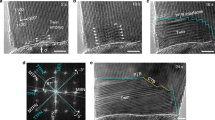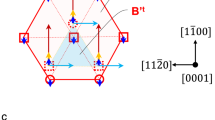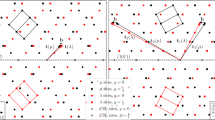Abstract
The atomic structure of {10 \(\bar{{\bf{1}}}\) 2} twin boundary (TB) from a deformed Mg-3Al-1Zn (AZ31) magnesium alloy was examined by using high-resolution transmission electron microscopy (HRTEM). By comparing the lattice structure of TB with the previously established model, a kind of special atomic combinations, here named primitive cells (PCs), were discovered at the TB. The PCs reorientation induced mechanism of twinning in hexagonal-close-packed (HCP) crystals was hence verificated. Meanwhile, the relationship between the misorientation of adjacent layers of PCs and the width of TB was discussed. The verification of the mechanism clarifies the twinning mechanism in HCP crystals and opens up opportunities for further researches.
Similar content being viewed by others
Introduction
The deformation twinning from HCP crystals has been heavily researched1,2,3,4,5,6 due to the role it plays in the dominant deformation mode and the strengthening mechanism of materials7,8,9,10. The details of a number of phenomena relevant to twinning, including the micro-structure of TBs, the TB migration characteristics, and the twin nucleation remain obscure due to the lack understanding of the twinning mechanism on an atomic scale. The researches on HCP twinning can be divided into two levels of closely related topics: the structure of TBs11,12 and the law of atomic migration in twinning. The TBs were recently considered to be composed of a mixture of dislocations13,14,15 and the dynamic twinning process was considered to be governed by either the glide of defects on their twin planes16,17,18,19, or shuffling20,21,22,23. The authors of this paper had established a new theoretical model based on “atomic groups rotation” to describe the atomic motion in HCP twinning elsewhere24,25,26, which was specially concerned with the integrity of atomic motion. In this paper, the theoretical hypothesis is to be verificated and discussed. To avoid ambiguity the expression “atomic groups” was replaced by “PCs”.
Results
The picture recording of the atomic array around the TB of a {10\(\overline{1}\)2} twin from the deformed AZ31 alloy was obtained by HRTEM detection (Fig. 1a). The image was divided into three parts consisting of the parent, twin, and TB. The orientations of the parent and the twin were symmetrical about the {10\(\overline{1}\)2} twinning plane, but not the TB. The TB was not an imagined thin interface composed of single-layered atoms, but a large range of distorted lattice regions composed of muti-layered atoms. Around the TB, some atoms gathered together closely, making them distinguishable in the formation of some specific atomic combinations, as denoted by the diamonds in Fig. 1b,c. According to the geometric shape characteristics, these atomic combinations are identified as the proposed “PCs”. To clarify that the PCs observed in the TB region in Fig. 1 are not artifacts, the corresponding Fast-Fourier-Transform (FFT) patterns of Fig. 1b,c (Fig. 1d,f) together with the FFT patterns of the neighboring parent and twin regions (Fig. 1a) were provided. The result indicates that the FFT patterns of the PCs are not simply a combination of the FFT patterns of the twin and parent regions.
Some related literature can also verify the existence the PCs in HCP twinning. Figure 2a was the HRTEM image of {10\(\overline{1}\)2} TB of the Mg97Zn1Y2 alloy27. Figure 2b is the enlarged view of the area enclosed by the box in Fig. 2a, where the reorientating PCs can be clearly observed, as indicated by the diamonds. Figure 2c was a schematic of HCP {10\(\overline{1}\)2} twinning by shuffle mechanism28, where the PC can also be distinguished as indicated by the added dotted line parallelograms. Figure 2d was the diagram of {10\(\overline{1}\)2} twinning nucleation in Mg obtained by atomistic simulations29. Around the TB, the PCs can also be marked off, as indicated by the diamonds. In summary, the appearance of PCs in HCP twinning is universal.
Similar discoveries in other literature: (a) {10 \(\overline{1}\) 2} TB of Mg97Zn1Y2 magnesium alloy detected by HRTEM; (b) enlargement of the block area in (a); (c) shuffles in projection view along the 〈1 \(\overline{2}\) 10〉 zone axis in HCP structures; and (d) a partial dislocation bn in the {10 \(\overline{1}\) 2} twin nucleation of Mg obtained by atomistic simulations.
Discussion
According to the PC model, the PCs were considered to rotate as a whole to induce the migration of TB. However, the specific mechanism depends on the structure of the TB. As mentioned above, the TB was composed of layers of PCs oriented between the parent and the twin. Although the total misorientation of PCs between the parent and the twin is fixed, the misorientation between adjacent layers of PCs depends on the width of TB, namely the number of layers of PCs.
The simplest TB structure is that there is only one layer of PCs serving as the TB, as indicated in Fig. 3. The orientation of PCs at the TB is between that at the parent and the twin. Figure 3(a–e) illustrates the process of the migration of the TB, where the reorientation of PCs make the TB sweep over the lattice and transform the parent into the twin. The border between adjacent layers of PCs presents ‘steps’ shape due to the lattice distortion (Fig. 3b–f), which was named twinning dislocation elsewhere4. When the PCs in Fig. 3 rotate anticlockwise the TB migrates along the arrows, namely, twinning occurs. As a requirement for the activation of PC rotation, the PCs must break through the lattice resistance sustained from the surrounding atoms. The resistance was closely linked to the misorientation θ between two adjacent layers of PCs (suppose that the misorientation was uniform). For the TB composed of a single layer of PCs, θ = α/2, α denotes the total misorientation of PCs from parent to twin. When this equation is applied to {10\(\overline{1}\)2} twinning in magnesium, α ≈ 15.9°, θ ≈ 8°.
Often cases vary from the above hypothesis. Because TB is usually composed of muti-layered PCs. Figure 4a presents a HRTEM image of {10\(\overline{1}\)2} TB containing three layers of PCs in AZ31 alloy. Figure 4b is the schematic of distribution of PCs orientations corresponding to the box in Fig. 4a. The arrows denote the orientations of the PCs. As the arrows show, the PCs exhibit a strong gradual reorientating inclination from the parent to the twin. The five arrows form four misorientations, α1, α2, α3, and α4, between every two adjacent layers (Fig. 4c). Thus, the total misorientation of PCs from parent to twin can be expressed as:
If these reorientating PCs were well-distributed from parent to twin, the above equation changes to:
where θ is the average misorientation between adjacent PCs. By extension, the value of θ for a TB contains n layers of PCs can be expressed as:
Thus, when this equation is applied to the case seen in Fig. 4b (where α ≈ 15.9°, n = 3), θ ≈ 4°; and when it is applied to the TB with the width of d2 that consisted of approx. 15 layers of PCs, θ ≈ 1°. (Fig. 1a). Apparently, the resistance for twinning to break through decreases with the increasing number of layers of PCs. In another word, an increased number of layers of PCs can reduce the critical resolved shear stresses (CRSS) required in twinning activation. These conclusions may help to explain or predict phenomena regarding the TB movement. For example, for the TB shown in Fig. 1a the width of TB at the tip was larger than at the edge (Fig. 1a), which resulted in a more rapid growth along the longitudinal direction. The establishment of PC model is also helpful to explain the mechanism of twin nucleation. Since a twin was formed from a nucleus during TB migration from inside to outside, an inverse process can restore the original appearance of the nucleus. The verification of the PC mechanism opens the opportunity for further researches relevant to twinning.
Conclusions
The atomic combinations discovered at the TB were identified as proposed PCs in accordance to their characteristics, verifying the PC induced mechanism. The twinning process was induced by the rotation of the PCs. To accomplish this, the PCs must overcome the resistance from the surrounding lattice that was closely related to the CRSS. This was not determined by their total rotational angle from the parent to the twin, but rather from the misorientation between adjacent PCs.
Methods
A cuboid sample was cut from a hot-rolled AZ31 sheet with a dimension of 30 × 30 × 22 mm3 in the rolling direction, transverse direction, and normal direction. The sample was compressed by about 7% at a strain rate of ~10−3 s−1 at room temperature, with the loading direction parallel to the rolling direction. The HRTEM sample was prepared via low temperature ion thinning. A FEI Tecnai F30-G2 electron microscope with a voltage of 300 kV was used to carry out the HRTEM observations.
References
Jaswon, M. A. & Dove, D. B. The crystallography of deformation twinning. Acta crystal 13, 232–240, https://doi.org/10.1107/S0365110X60000534 (1960).
Bevis, M. & Crocker, A. G. Twinning modes in lattices. Proc Roy Sot A 313, 509–529, https://doi.org/10.1098/rspa.1969.0208 (1969).
Serra, A., Bacon, D. J. & Pond, R. C. The crystallography and core structure of twinning dislocations in HCP metals. Acta Metall 36, 3183–3203, https://doi.org/10.1016/0001-6160(88)90054-5 (1988).
Christian, J. W. & Mahajan, S. Deformation twinning. Prog Mater Sci 39, 1–157, https://doi.org/10.1016/0079-6425(94)00007-7 (1995).
Serra, A. & Bacon, D. J. A new model for {101-2} twin growth in HCP metals. Phil Mag A 73, 333–343, https://doi.org/10.1080/01418619608244386 (1996).
Niewczas, M. Lattice correspondence during twinning in hexagonal close-packed crystals. Acta Mater 58, 5848–5857, https://doi.org/10.1016/j.actamat.2010.06.059 (2010).
Kaschner, G. C. et al. Role of twinning in the hardening response of zirconium during temperature reloads. Acta Mater 54, 2887–2896, https://doi.org/10.1016/j.actamat.2006.02.036 (2006).
Stanford, N. & Barnett, M. R. Effect of particles on the formation of deformation twins in a magnesium-based alloy. Mater Sci Eng A 516, 226–234, https://doi.org/10.1016/j.msea.2009.04.001 (2009).
Yu, Q. et al. Strong crystal size effect on deformation twinning. Nature 463, 335–338, https://doi.org/10.1038/nature08692 (2010).
Lentz, M., Risse, M., Schaefer, N., Reimers, W. & Beyerlein, I. J. Strength and ductility with {101-1}–{101-2} double twinning in a magnesium alloy. Nat commun 7, 11068, https://doi.org/10.1038/ncomms11068 (2016).
Yu, Q. et al. The nanostructured origin of deformation twinning. Nano Lett 12, 887–892, https://doi.org/10.1021/nl203937t (2012).
Tu, J., Zhang, X. Y., Ren, Y., Sun, Q. & Liu, Q. Structural characterization of {101-2} irregular-shaped twinning boundary in hexagonal close-packed metals. Mater Charact 106, 240–244, https://doi.org/10.1016/j.matchar.2015.05.032 (2015).
Serra, A., Bacon, D. J. & Pond, R. C. Dislocations in interfaces in the hcp metals–I: Defects formed by absorption of crystal dislocations. Acta Mater 47, 1425–1439, https://doi.org/10.1016/S1359-6454(99)00016-6 (1999).
Zhang, X. Y. et al. Twin boundaries showing very large deviations from the twinning plane. Scr Mater 67, 862–865, https://doi.org/10.1016/j.scriptamat.2012.08.012 (2012).
Xu, B., Capolungo, L. & Rodney, D. On the importance of prismatic/basal interfaces in the growth of (101-2) twins in hexagonal close packed crystals. Scr Mater 68, 901–904, https://doi.org/10.1016/j.scriptamat.2013.02.023 (2013).
Serra, A., Pond, R. C. & Bacon, D. J. Computer-simulation of the structure and mobility of twinning dislocations in hcp metals. Acta Metall Mater 39, 1469–1480, https://doi.org/10.1016/0956-7151(91)90232-P (1991).
Wang, J., Liu, L., Tomé, C. N., Mao, S. X. & Gong, S. K. Twinning and detwinning via glide and climb of twinning dislocations along serrated coherent twin boundaries in hexagonal-close-packed metals. Mater Res Lett 1, 81–88, https://doi.org/10.1080/21663831.2013.779601 (2013).
Wang, H., Wu, P. D., Wang, J. & Tomé, C. N. A crystal plasticity model for hexagonal close packed (HCP) crystals including twinning and de-twinning mechanisms. Int J Plast 49, 36–52, https://doi.org/10.1016/j.ijplas.2013.02.016 (2013).
Liu, B. Y. et al. Twinning-like lattice reorientation without a crystallographic twinning plane. Nat Commun 5, 3297, https://doi.org/10.1038/ncomms4297 (2014).
Li, B. & Ma, E. Atomic shuffling dominated mechanism for deformation twinning in magnesium. Phys Rev Lett 103, 035503, https://doi.org/10.1103/PhysRevLett.103.035503 (2009).
Li, B. & Ma, E. Reply to comment on ‘Atomic shuffling dominated mechanism for deformation twinning in magnesium’. Phys Rev Lett 104, 029604, https://doi.org/10.1103/PhysRevLett.104.029604 (2010).
Wang, J., Yadav, S. K., Hirth, J. P., Tomé, C. N. & Beyerlein, I. J. Pure–shuffle nucleation of deformation twins in hexagonal–close–packed metals. Mater Res Lett 1, 126–132, https://doi.org/10.1080/21663831.2013.792019 (2013).
Li, B. & Zhang, X. Y. Global strain generated by shuffling-dominated twinning. Scr Mater 71, 45–48, https://doi.org/10.1016/j.scriptamat.2013.10.002 (2014).
Jiang, S., Liu, T., Lu, L., Zeng, W. & Wang, Z. Atomic motion in Mg–3Al–1Zn during twinning deformation. Scr Mater 62, 556–559, https://doi.org/10.1016/j.scriptamat.2009.12.038 (2010).
Jiang, S., Liu, T., Chen, C. & Jiang, X. Law of Atomic Motion during {101-1} Twinning in Magnesium Alloys. Mater Trans 52, 1585–1588, https://doi.org/10.2320/matertrans.MC201022 (2011).
Jiang, S., Zeng, B. & Douadji, L. Atomic group rotation mechanism of {101-3} twinning in HCP materials. Int J Mater Res 19, 413–416, https://doi.org/10.3139/146.111038 (2014).
Matsuda, M., Ii, S., Kawamura, Y., Ikuhara, Y. & Nishida, M. Interaction between long period stacking order phase and deformation twin in rapidly solidified Mg97Zn1Y2 alloy. Mater Sci Eng A 386, 447–452, https://doi.org/10.1016/j.msea.2004.08.006 (2004).
Wang, J., Hirth, J. P. & Tome, C. N. (101-2) Twinning nucleation mechanisms in hexagonal-close- packed crystals. Acta Mater 57, 5521–5530, https://doi.org/10.1016/j.actamat.2009.07.047 (2009).
Li, B. & Zhang, X. Y. Twinning with zero twinning shear. Scr Mater 125, 73–79, https://doi.org/10.1016/j.scriptamat.2016.07.004 (2016).
Acknowledgements
This work is supported by Grants from National Natural Science Foundation of China (No. 51301215), Talent project of Chongqing University of Arts and Sciences (R2014CJ04; 2017RXC24), The Scientific Technological Research Program of Chongqing Municipal Education Commission (KJ1601117) and Chongqing Research Program of Basic Research and Frontier Technology (No. cstc2017jcyjBX0051). Thanks are due to Pro. Xiyan Zhang for assistance with the experiments and valuable discussion.
Author information
Authors and Affiliations
Contributions
S. Jiang managed the research activities. S. Jiang and Z.T. Jiang were involved in the design of the study, the discussion of the results and in the preparation of the manuscript. Q.W. Chen contributed to the sample selection and HRTEM experiments. All authors reviewed the manuscript.
Corresponding author
Ethics declarations
Competing Interests
The authors declare no competing interests.
Additional information
Publisher’s note: Springer Nature remains neutral with regard to jurisdictional claims in published maps and institutional affiliations.
Rights and permissions
Open Access This article is licensed under a Creative Commons Attribution 4.0 International License, which permits use, sharing, adaptation, distribution and reproduction in any medium or format, as long as you give appropriate credit to the original author(s) and the source, provide a link to the Creative Commons license, and indicate if changes were made. The images or other third party material in this article are included in the article’s Creative Commons license, unless indicated otherwise in a credit line to the material. If material is not included in the article’s Creative Commons license and your intended use is not permitted by statutory regulation or exceeds the permitted use, you will need to obtain permission directly from the copyright holder. To view a copy of this license, visit http://creativecommons.org/licenses/by/4.0/.
About this article
Cite this article
Jiang, S., Jiang, Z. & Chen, Q. Deformation twinning mechanism in hexagonal-close-packed crystals. Sci Rep 9, 618 (2019). https://doi.org/10.1038/s41598-018-37067-8
Received:
Accepted:
Published:
DOI: https://doi.org/10.1038/s41598-018-37067-8
This article is cited by
-
Morphological evolution of irregularly shaped Au nanoparticles during the sintering process and their mechanical performance
Computational Particle Mechanics (2023)
-
Atomic behavior of single-crystal Ti nanowire plastic deformation under high strain rate simple tension
The International Journal of Advanced Manufacturing Technology (2020)
Comments
By submitting a comment you agree to abide by our Terms and Community Guidelines. If you find something abusive or that does not comply with our terms or guidelines please flag it as inappropriate.







